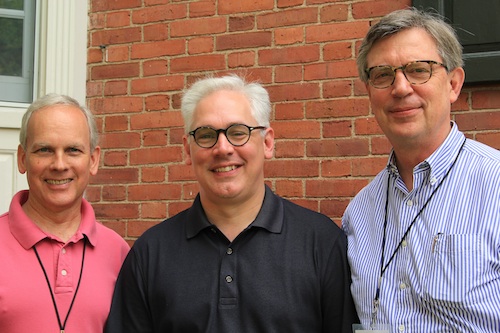
Problematizing the Digital Window: Rethinking the Gap between Technology and Bodily Presence
by Bethany Carlson, M.Div ‘16
Luther Memorial Church serves a congregation that is partially invisible. At least that’s what senior pastor Franklin Wilson implies when he points out that the church’s web presence has caused a handful of young adults to request baptism or wedding ceremonies in a space they have never physically set foot in. “Even though they have yet to attend one Sunday morning service,” he says, “several of them told us, ‘This place—it just feels like home.’”
Wilson, who has been at Luther Memorial since 2008, says the congregation of about one thousand members consists largely of students, retirees, and empty-nesters. Built in the 1920s, Luther Memorial serves as both a parish and a student center. It holds the title of the oldest campus ministry among Lutherans in a public university in the United States. The church building is located on University Avenue, a main drag on the perimeter of University of Wisconsin’s Madison campus, and it’s literally surrounded by students, or as associate pastor Brad Pohlman wryly put it, by “42,000 underage drinkers.”
The college students who show up typically use Luther’s website as a kind of “virtual door” to preview the church and get a sense of what it is about, says Pohlman, though he eventually retracts this metaphor, rephrasing it as a “virtual window that’s sometimes opaque.”
The church’s website (luthermem.org) is text-heavy and cluttered—nothing to write home about. When I visited it, it seemed to me that nothing jumps out, so every text box and drop-down menu gets equal weight and attention. The search bar is foregrounded by the same rich, warm brown that sets off the church’s logo with this subhead, in a nearly illegible white script: At Luther Memorial, Christ lives and welcomes all.
As they seek to welcome all, Luther Memorial’s leadership team wonders if they’ve overlooked how to interact with those who aren’t bodily present. They are asking, in other words, “How can a community assembled around the incarnate word and sacramental body and blood of Christ flourish amid a disembodied culture in which virtual reality may trump actual embodied life?”
Bruce Bengtson, director of music and internationally acclaimed organist, performs a 30-minute organ recital each Wednesday that is uploaded via YouTube to the church’s website. Listeners, though usually complete strangers, occasionally take the time to write notes of appreciation and send them to the church email address. But the church staff is so busy that these emails rarely receive replies. Bengtson, whose tenure at Luther Memorial spans nearly four decades, wonders if it’s a missed opportunity to connect.
A virtual tour of the building is another popular feature on Luther Memorial’s website. Wilson describes it as being “pretty aseptic”—no bodies, just empty pews. The tour offers a Google-streets-like close-up of the church from the exterior, and viewers can also peruse interior shots of the narthex, nave, columbarium, balcony, great room, library, preschool, and choir room. This tour, remarks Pohlman, lacks all of the bodily noise and messiness of the congregation as a worshipping community.
Wilson, Pohlman, and Bengtson recognize a growing disconnect between the inauthenticity of the church’s web presence as an “avatar evangelist” juxtaposed with the “real, embodied” worshipping community. They also worry about keeping up with rapid change. Pohlman remarks that his own kids have long since given up popular social media sites like Twitter, Facebook, and Instagram for new ones like SnapChat and Reddit. “It’s typical of the church to be just catching up when it’s too late,” he says.
Dr. Teresa Berger, who served as the ISM faculty liaison for Luther Memorial during the week of the Congregations Project, argued that technology can provide a much more viable path to experiencing authentic worship than the Luther Memorial team realizes. Berger, who has done extensive research on virtual communities of worship, contends that the internet has made available a kind of co-presence to worshipers who may be physically absent. “Physical co-presence alone doesn’t guarantee ecclesial community,” she insists. “Neither does absence.”
Online forms of religiosity are often dismissed because they seem too easy, Berger says, but that’s discounting the increasing evidence that cyber churches around the globe are meeting the needs of those who have been hurt or rejected by traditional church experiences. Further, many who frequent cyber church sites have extenuating circumstances, such as medical conditions or physical limitations, that prevent them from physically participating in services at brick-and-mortar locations. For these and for others who simply prefer or feel more deeply connected online, cyber worship can be a positive means of personalizing liturgical experience, according to Berger.
Wilson, Pohlman, and Bengtson challenged this approach. “Embodied liturgy is difficult and provocative,” Wilson says. “The kneeling, the singing, the incense…it’s not always comfortable.” Luther Memorial feels called to embrace the bodied church in liturgy.
The tension often perceived to exist between bodies and technology is an artificial one, Berger believes. “There’s a dichotomy there that insists you can’t have real community online.” She points out that most people have integrated internet-accessing devices like smart phones and tablets into their daily practices. “So it’s an unreal distinction that real life is lived offline.”
But the leaders of Luther Memorial still worry that Sunday morning attendance is decreasing and that members may not support the worshiping body on a regular basis through their actual physical presence.